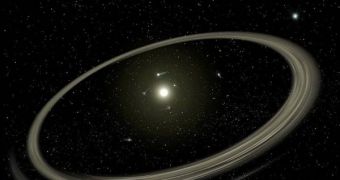Over the past two decades, astronomers have discovered more than 300 exoplanets, orbiting stars either nearby or very far away. Observation techniques have become so sensitive, that they can identify variations in a stars' glow from light-years away and determine if they have been caused by a planet, a moon, an asteroid, or something else. However, it was only recently that astrophysicists were able to answer a long-standing question, namely how come there were, in some cases, “holes” in a star's orbit, which attested to the existence of a planet, but without actually holding it.
A new scientific study comes to suggest that stellar tides may actually be responsible for this state of affairs, in that the celestial bodies may have simply prompted the planets orbiting them to fall towards the center of gravity of the star system and get destroyed. This means that it's not the fault of the observatories that they can't see the planets. Rather, simply, they no longer exist, having fallen into the stars that created them in a long and slow process.
University of Washington Astronomer Rory Barnes explains that the idea of a star being able to pull its planets inside was predicted just a few years back, and that the recent investigations have already proven the model right. “When we look at the observed properties of extrasolar planets, we can see that this has already happened – some extrasolar planets have already fallen into their stars,” the expert shares. Together with lead author Brian Jackson and co-author Richard Greenberg, both from the Lunar and Planetary Laboratory at the University of Arizona, Barnes has co-authored a new study on the matter, which has been accepted for publication in this month's issue of the Astrophysical Journal.
“The orbits of these tidally evolving planets change very slowly, over timescales of tens of millions of years. Eventually the planet's orbit brings it close enough to the star that the star's gravity begins tearing the planet apart. So, either the planet will be torn apart before it ever reaches the surface of the star, or in the process of being torn apart its orbit eventually will intersect the star's atmosphere and the heat from the star will obliterate the planet,” lead author Jackson adds. “Tides distort the shape of a star. The bigger the tidal distortion, the more quickly the tide will pull the planet in.”
“For example, the rotation rates of stars tend to drop, so older stars tend to spin more slowly than younger stars. However, if a star has recently consumed a planet, the addition of the planet's orbital angular momentum will cause the star to rapidly increase its spin rate. So, we would like to look for stars that are spinning too fast for their age,” Jackson concludes.

 14 DAY TRIAL //
14 DAY TRIAL //